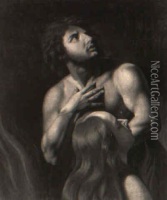Fleury-Francois Richard Paintings
Fleury-François Richard, born on February 25, 1777, in Lyon, France, was a significant figure in the early 19th-century French painting scene, particularly known for his contributions to the Troubadour style. This style, part of the wider Romantic movement, emphasized medieval and early Renaissance subjects, often imbuing them with a nostalgic and emotional depth. Richard's works played a pivotal role in the popularization of this style, which sought to escape the present by idealizing the past.
Richard's artistic journey began in Lyon but soon after, he moved to Paris to further his studies. In Paris, he became a student of Jacques-Louis David, the leading French painter of the neoclassical movement. Despite David's influence, Richard diverged from his teacher's emphasis on classical antiquity, instead developing a fascination with the medieval period, which would define his career. His painting "Valentine de Milan pleurant la mort de son époux" (Valentine of Milan Mourning her Husband), exhibited in 1802, was among the works that cemented his reputation. This painting, with its detailed portrayal of grief and historical accuracy, exemplified the Troubadour style and earned him significant acclaim.
Throughout his career, Richard continued to delve into historical and literary themes, drawing inspiration from various sources, including the works of Shakespeare and Sir Walter Scott. His attention to detail and the emotional intensity of his subjects appealed to a wide audience, including the royalty and nobility of his time. Among his notable patrons was Empress Joséphine, the wife of Napoleon Bonaparte, for whom he produced several works.
In addition to his historical paintings, Richard was also known for his portraits and landscapes, which exhibit the same meticulous attention to detail and vibrant storytelling. His influence extended beyond his own works, as he played a role in the education of future artists, including Théodore Géricault, a prominent figure in the Romantic movement.
Richard's contributions to art were recognized in his lifetime; he was awarded the Legion of Honour, France's highest order of merit, for his artistic achievements. After his death on March 14, 1852, in Écouen, a suburb of Paris, his legacy continued to influence the Romantic movement and the artistic exploration of historical themes. Today, Fleury-François Richard is remembered not just for his unique stylistic contributions but also for his role in bridging the neoclassical and Romantic periods in French art.














